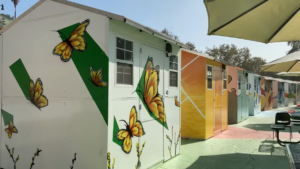The problem of homelessness continues to grow in Los Angeles. The latest point-in-time count showed more than 66,000 people were experiencing homelessness.
According to the L.A. Homeless Services Authority, that count reflects a 13% increase in homelessness between 2019 and 2020.
Local lawmakers are looking to reverse these trends by moving more individuals who live on streets into housing. In August, the L.A. City Council set a goal to construct 25,000 new housing units — both permanent and temporary — by 2025.
L.A. voters have already enacted Proposition HHH. The $1.2 billion measure promised 10,000 housing units, but slow progress has been made on construction.
While permanent housing can take a long time to build, Los Angeles is establishing a number of temporary options to get unsheltered individuals off the streets more quickly. One, for example, is a community of “tiny homes” in Highland Park, which became the largest complex in the nation when it opened to residents in November.
The Arroyo Seco Tiny Home Village features 117 units, and is open to up to 234 individuals from within a 3 mile radius, including the neighborhoods of Boyle Heights, Eagle Rock, El Sereno, Glassell Park, Highland Park and Monterey Hills.

Each dwelling measures eight by eight feet, and is equipped with electricity, air conditioning and heating. Anybody living in a tiny home will have access to different supportive services such as mental health care, substance abuse counseling and job training.
Ken Craft, founder and CEO of Hope of the Valley, says that while emergency housing allows the unsheltered to sleep, it has little privacy and would not want anybody staying there for very long.
“We have to get people off the streets. We have to create win-win-win situations,” Craft says. “Wins for those experiencing homelessness. Wins for our community.”
Hope of the Valley Rescue Mission is a nonprofit organization founded in 2009. It began as a ministry in a church looking to feed the homeless. Now, Hope of the Valley Rescue Mission manages daily operations at six of the seven small-home communities that have opened in the City of L.A. this year.
The Midnight Mission is located in downtown Los Angeles, near Skid Row. It became a non-profit organization in 1922. It is an emergency shelter offering food, shelter, counseling, education, life skills and mental health services to the most vulnerable people in the city of Los Angeles.
Mike Arnold, President and CEO of Midnight Mission says that in order for a permanent home or an interim home to function well, it should provide different types of services that address the cause of what made the unhoused individuals land on the streets in the first place. In doing so, they can then help in successfully moving them into permanent housing that will keep them from going back to the streets.
Arnold says the City of Los Angeles needs resources to keep unhoused individuals off the streets, even if only temporarily
“The reality is,” Arnold says, “that if we had enough housing that we could afford to put people into right now and we had services to be able to service them into that housing then we wouldn’t need any of the other interventions. But we have nowhere near that number of housing.”
“Emergency situations are not designed for long stays” Arnold added, “but when you don’t have any housing to get people into, the emergency shelter becomes a really long stay.”
Shelters have rules some unhoused individuals choose to not follow. Some of them include curfew, and having lights off at a certain time. While homeless individuals may appreciate this, some prefer to sleep outside.
Arnold says that one of Midnight Mission’s main goals is to build relationships with those experiencing homelessness.
PATH (People Assisting the Homeless) is a non-profit organization that helps unhoused individuals, families and veterans transition from living on the street to owning their own home.
Senior director Stephen Fiechter says they try to build a relationship with people by meeting them in the situation they are in, and hope to elevate a trust that has been destroyed.
“Whatever supports people need, those are the resources they are connected with and then as housing is available, and again that’s a big hurdle in Los Angeles, to find affordable housing for people,” Fiechter says. “But as those resources are identified…they get to make a choice on where they live, like the rest of us, we hope. Then they are able to move in, often times with parental subsidy for a short period or longer, security deposit, and so forth.”
“Ultimately, we want people to have jobs,” Craft says. “We want them to be reintegrated back into the community.”
This story was reported by Vanessa Garcia, Kaylenn Gomez, Alahna Martinez and Melody Soto.

 Tweet this Video
Tweet this Video Share on Facebook
Share on Facebook Share via E-mail
Share via E-mail

